A little while ago I embarked on reviewing Eaglemoss’ Starship Collection with a look at the XL Enterprise-A. And before coming back to open some more of the larger ships, I thought I’d detour into some ships from the regular-sized fleet. And because these are smaller (roughly five inches long) and a little less detailed, I figured I’d cram as many as I could into one review. To get started, I selected five ships that I feel are the most iconic ships of The Next Generation, and also a pretty good survey of the different space powers. I’m also calling this Part 1 because, while I don’t know when Part 2 will come along, or what will be in it, I do know there will be plenty more TNG ships to look at later on down the road.
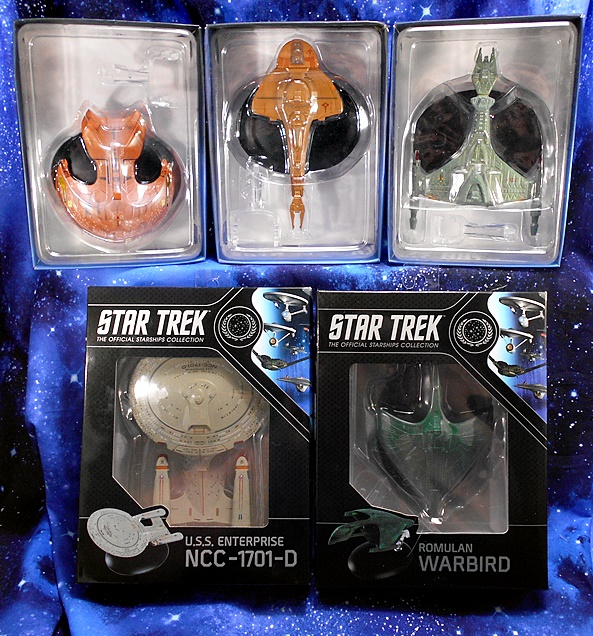
And here are they are! The Federation Flagship, The Romulan Warbird, The Klingon Vor’Cha Class Battlecruiser, The Ferengi Marauder, and the Cardassian Galor Class Cruiser. As you can see these come in two styles of packaging. The Enterprise and Warbird came in window boxes that are specific to the ship inside and include some nice artwork and a Collect Them All layout for the back panels. The other three ships come in generic boxes with no tops, just the clear cover for the plastic tray. I dig the window boxes more, but I have to respect the others that just let the models do all the talking. The Enterprise and Warbird come with booklets inside the boxes, while the others come with regular size magazines, usually in a bag with the box. The magazines are kind of hit or miss with me. I like the ones that focus on the ship, but clearly not all ships have enough backstory and details to fill a magazine so some just talk about the aliens or the stories they were featured in. Let’s start with the Flagship!
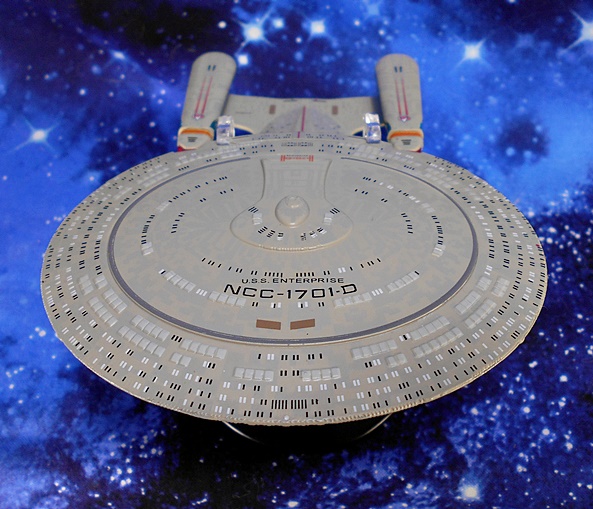

I’m going to save my long-winded opinions on the 1701-D, it’s design, and what the ship means to me for when I spotlight the XL version in the near future. For now let me just say that I’m blown away by the amount of detail Eaglemoss packed into this little ship. For the longest time, I didn’t collect this line because I just didn’t think the scale was capable of retaining the kind of details and quality of sculpt I was looking for. And we’ll see in a little bit that prejudice wasn’t entirely unfounded, but when it comes to this Enterprise, boy was I wrong! Just look at that saucer! Check out all the tiny windows individually painted either lit or dark! And escape pods! The crisp registry and sharp paint on the phaser ring! You even get some oh so subtle aztec-patterns. Granted, the Enterprise-D’s saucer is a pretty wide canvas to work on, but it’s still damn impressive.


They really nailed the profile of the ship as well. The tiny windows continue on to the Stardrive Section. You also get some purdy red and blue translucent plastic used in the warp nacelles and super tiny registry printed on the struts. If you look closely you can even see that they applied some of the subtle panel shading to the nacelles themselves. I’d also like to acknowledge that they did a nice job hiding the seams on this ship in plain sight by putting them in appropriate spots. The model is part metal, but mostly plastic and while it has a nice heft to it, those warp nacelles feel fragile!

The same red translucent plastic used for the fronts of the warp nacelles is used for the three impulse engines. And there’s a sharp red racing stripe bisecting the ship from the saucer all the way down to the aft torpedo launcher. You also get the Deltas and racing stripes on tops of each warp nacelle the name printed on the horizontal face of the struts, and the name and registry printed in front of the Primary Shuttlebay Door. Want me to complain about something? The Shuttlebay Doors could have been more detailed. That’s all I got!


The deflector dish is comprised of more of that lovely red and blue translucent plastic, and the ventral side of the ship shares all the great detail as the dorsal section, complete with individually painted windows, and registry printed on the underside of the saucer. And before moving on to the next ship, this is also as good a place as any to talk about the stand, which is very high quality and very well designed. The base is heavy and made of metal with a felt bottom. The device that holds the ship up grabs the saucer beside each of the saucer impulse engines and also has notches for the Stardrive Section to rest on. It’s clear so it tries to obscure the view of the ship as little as possible. I took some issues with this style of stand when I looked at the XL Enterprise-A, but for a ship this size, I think it’s a pretty solid design that also lets you detach the ship and handle it without much trouble. Let’s have a look at the Romulan Warbird next.


Oh boy do I love this design! Introduced in the Season 1 Finale, The D’deridex Class was fresh, original, menacing, and unlike anything we’ve seen before. And yet it has since become as iconic a Romulan ship design to me as the original Romulan Bird of Prey that I grew up with. And once again, Eaglemoss has done an amazing job recreating this behemoth battleship in a nearly pocket-sized scale. The green finish has a nice metallic sheen but it’s also washed over in some parts to help bring out some of the sculpted details and give it a bit of a weathered look, particularly along the rear edges of the top and bottom hulls. The ship always looked a little too new on the small screen, but this more seasoned version looks like it would have been at home on the big screen if the Warbird had ever made it into any of the TNG films.

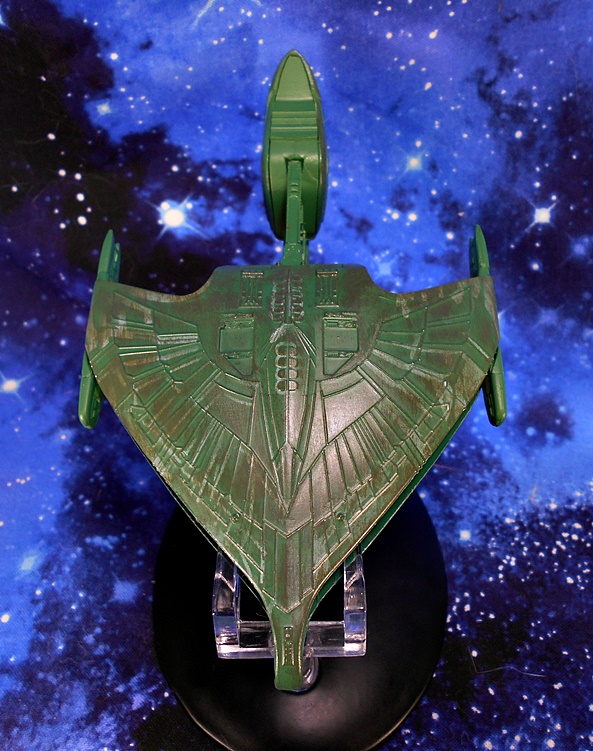
There are panel lines a plenty on the outside and inside recreating a fanning feather-like pattern, as well as a segmented spine that runs up the center of the ship’s mighty back. It evokes the predatory bird motif without having to be quite as on the nose, and some might say cheesy, as the 1960’s Bird of Prey design.



And much like the Enterprise, the craftsman of this model didn’t spare any expense when it came to windows. The hull is positively littered with them and it goes a long way to illustrating just how gigantic this ship is. Just look at all the windows on the strut connecting the bottom of the forward section to the bottom hull. Wow, this is a big ship! I was hoping we would get a little of that translucent plastic in the warp nacelles, but here it’s just a greenish-yellow paint. It looks fine, but it could have looked better.


The stand here mirrors the particulars of the Enterprise stand, although this one is a lot less obtrusive, as it grabs the ship from behind and gives it an upward incline. As a result you can view the ship on the stand from some of its best angles and not have to worry about it getting in the way. On the downside, my stand will not stay in the base, which is only a problem if I forget and go to pick up the ship, as the clear piece and ship will come right out of the base. But stand malfunction set aside, this is a great model of this fierce Romulan Warship. And from one mighty Empire to another, let’s turn next to the Klingon Vor’cha Class Battlecruiser!

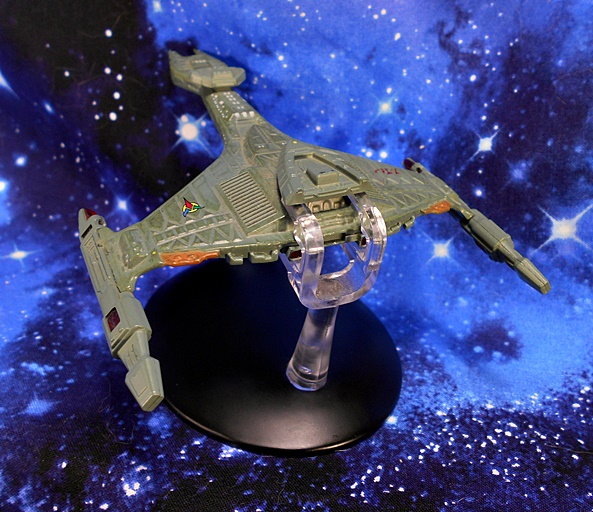
It’s no secret that TNG relied too heavily on the Klingon Bird of Prey. Oh, it’s an amazing ship design, but after being featured so prominently in Star Trek III, Star Trek IV, Star Trek V, Star Trek VI, oh yeah and Star Trek: Generations, it was nice to see a brand new Klingon ship eventually turn up in TNG, even if we had to wait until the 4th Season to get it. And The Vor’cha was an excellent design that invoked familiar Klingon elements while changing it up enough to make it still seem fresh to me. The Vor’cha is like a D7 on steroids with beefier engines and where the Command Deck on the D7 was at the terminal end of the boom, here it’s tacked on top and preceded by a Weapons Pod that looks like the Klingon equivalent of a giant Type-1 Hand Phaser. Ok, I guess that would be a Type-1 Hand Disruptor. But hopefully you get the point.



Once again there’s some excellent detailing on this little ship, although I’ll say straightaway that it doesn’t look quite as sharp or polished as either the Enterprise or the Warbird. Of course, that just may be that the Klingon ships tend to look a little grittier and less refined. The hull features very traditional Klingon Shield Plates, particularly in the wings leading out to the warp nacelles and in the area surrounding the Weapons Pod. In addition to lots of individual painted windows, you get the emblem of the Klingon Empire printed on the left wing and what I presume is the ship’s registry printed in Klingon on the right wing. Both of these last two details are also present on the undercarriage of the ship.


The warp nacelles makes use of that lovely red translucent plastic in the nacelles and it looks great, particularly with some light piping through them. You also get some orange paint on the Emergency Plasma Purge Vents located at the back edge of each wing. And like the Warbird, the Vor’cha has a wash that not only helps pick out the details in the sculpt but also gives it a well-weathered look suggesting that this Battleship has seen some action.


The stand here is very similar to the one used for the Warbird in that it grabs the ship from behind and allows you to view it from some of its best angles without getting in the way. And happily this stand holds together quite well. While this model doesn’t look as crisp as the first two ships, it certainly has a rugged and seasoned flavor about it that suits a ship in the Klingon Navy. And now that we’ve covered The Big Three, let’s work our way down to a couple of the lesser powers… starting with the Cardassian Galor Class Cruiser.
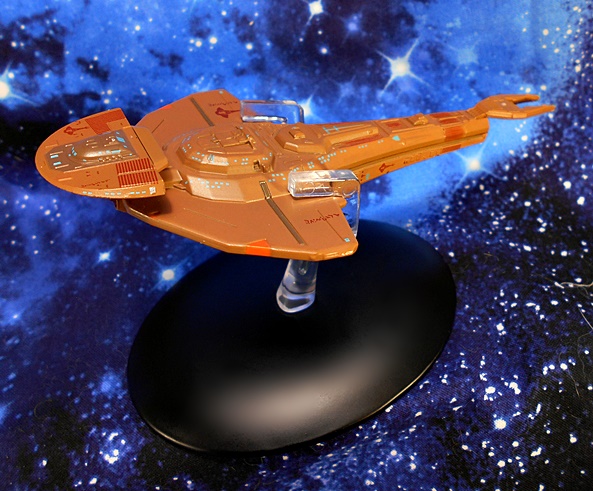


I was tempted to not include the Galor in this piece on iconic TNG ships because to me this ship really didn’t become iconic until Deep Space Nine and the Cardassians didn’t even show up until TNG was more than half over. Nonetheless, it first appeared in this series, so I’m throwing it in. I’ll also confess I was rather excited to look at it since I’ve never owned a model or toy of this ship before. The Galor is a very cool design, resembling an earwig and automatically giving me the willies. My only real nitpicks with it is that it doesn’t have that one sweet spot for a beauty shot like most other ships do. It doesn’t look like much when viewed at level profile or from dead on. Nonetheless, this is another great model for the line. On the surface, I thought this ship lacked detail, perhaps because it’s hull isn’t covered in panel lines. But once I got in close with the camera, it’s still got the same level of detail as the other ships including tiny windows, insignia and registry markings.


I really don’t know much about this ship’s anatomy, so I perused a set of blueprints so I could better understand I’m seeing. I presumed the orange triangles are weapon, but those are actually called out as the Warp Engines. How that works, I’m not sure, but cool! The model uses red translucent plastic for the Main Disruptor cannon, which apparently doubles as a Deflector Dish. Again, I’m not sure how that works, but cool! I really dig the hatches tucked under the wings, which are apparently for offloading cargo or troops.


Once again, we have the same type of stand, only hear it’s designed to grab the ship from behind it’s wings. It does obstruct the view a bit, but that’s why it’s cast in clear plastic. And to be fair, there’s really nowhere else it could have grabbed the ship and adequately supported it. And that brings me to my last stop on this trek…


I was in love with the Ferengi Marauder the first time I saw it. It’s a shame the Ferengi didn’t work out quite as the writers had planned and we rarely got to see this ship, because I think it’s a really cool design. The model favors paint applications over actual sculpted detail, with most of the hull being smooth. And I’d say that’s probably a fair representation of the screen appearance. And like the Warbird, the painted windows on this ship do a fine job of portraying just how big this ship is supposed to be. Still, I don’t think it would be unfair to say that this survey of ships is offering diminishing returns when it comes to the amount of detail injected into them. I didn’t really plan it that way, but there you go!
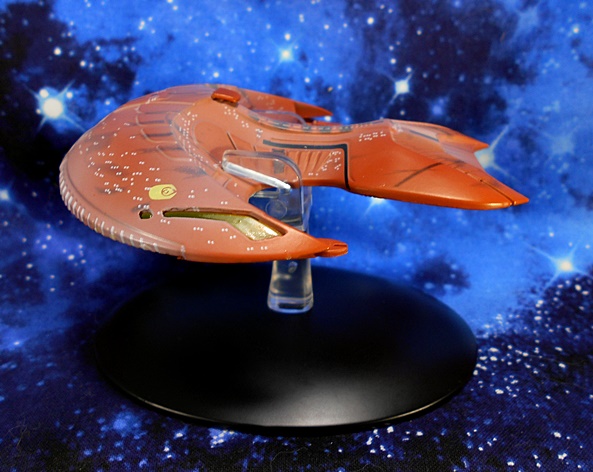
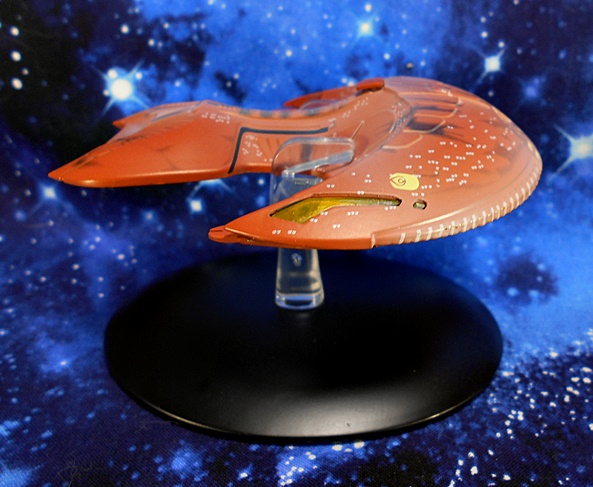

The model makes use of translucent yellow plastic used for the warp engines, which can be seen from the sides and the undercarriage as well and look pretty damn sharp. You also get the emblem of the Ferengi Alliance printed on each side just above these engines. The weapon emitters at the tips of the wings look like little pincers, and the notches that run alongside the bottom edge of the ship’s aft hump are all painted.

Unfortunately, there are two things about this model that really bug me. The first is that when viewed from the front, the crescent hump that makes up the back section of the ship doesn’t look tall or steep enough. The screen appearance makes it look a lot more pronounced when compared to the Command Section. Now, maybe that’s just me or maybe a trick of the camera, because I’m sure these models are based on detailed research, but it just doesn’t quite look right to me. Secondly, and less subjective, is the white wash they used. It dulls the color of the hull and I can’t comprehend what kind of effect they were going for here. It bothers me a lot with the ship in hand and even in my pictures it looks like the results of harsh lighting. At least the other wash they did to denote weathering looks great. I’d be keen to see them take a stab at this ship in the larger XL line and without the white wash.
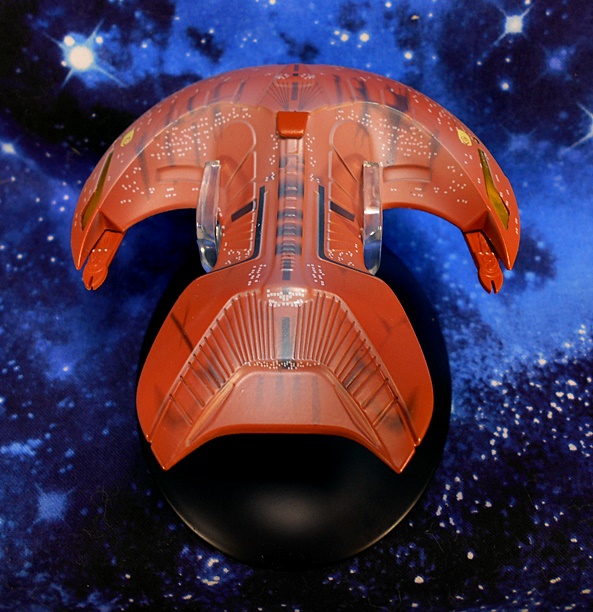


The stand grabs the ship from the front of it’s crescent and does a good job holding it and not being too obtrusive. I will, however, point out that, in the cases of all the stands, I worry about friction and how much taking the ships off and putting them back on will cause paint rubbing.


And there you have it, five iconic ships from The Next Generation all presented by Eaglemoss and, for the most part, they’re all very well done. Even the Marauder would be fine if they gave it a simple repaint. As a FASA miniature junkie from days long past, I’m always up for building me a fleet of little collectible Starships and Eaglemoss has me covered quite nicely with this series. These models are great examples of quality and craftsmanship and offer a fine alternative to fleet building if you’re looking for something more substantial than Micromachines and more varied than any other toy or model company has churned out. The magazines are a nice bonus, but they aren’t the high point of this line to me. The five ships I showcased today ran me between $17 and $25, which sure isn’t bad if you have that one (or handful of) special ship(s) you want to put on your desk. It does, however get rather pricey when you’re looking to Collect Them All, or at least a good chunk of them. On the other hand, it’s a big break from spending seventy-five bucks a pop for the bigger XL ships.

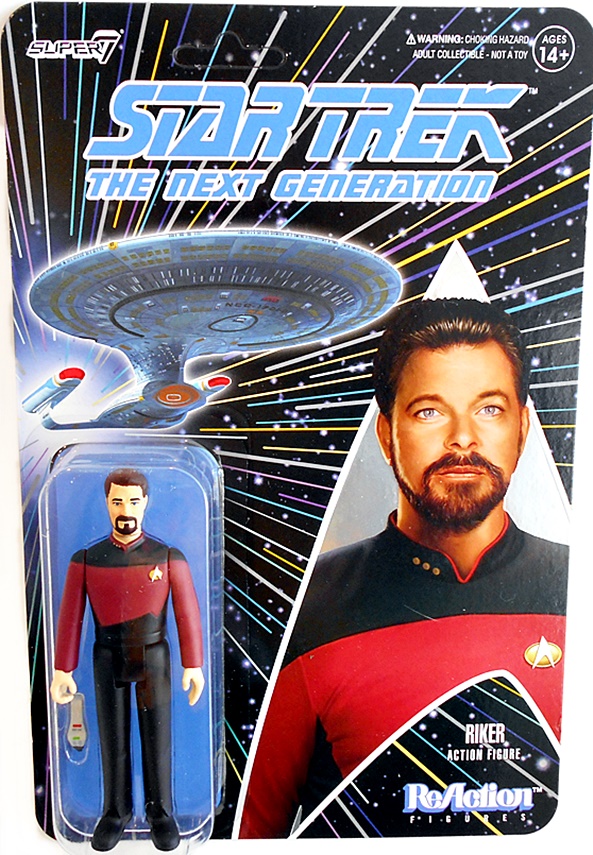












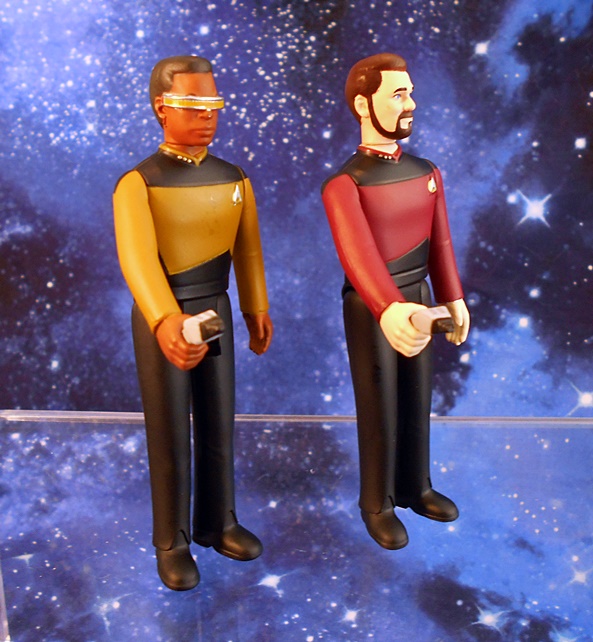





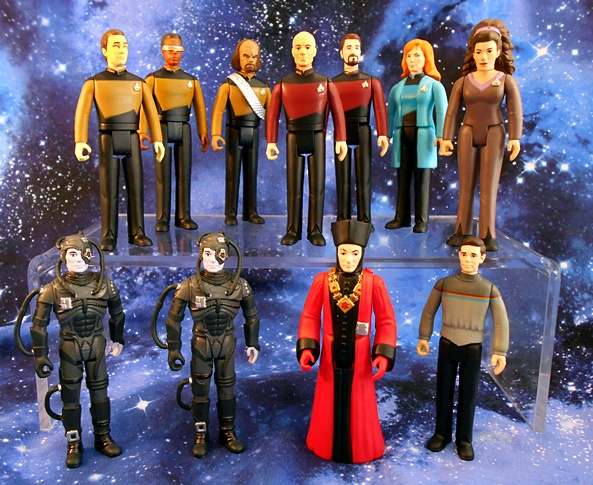



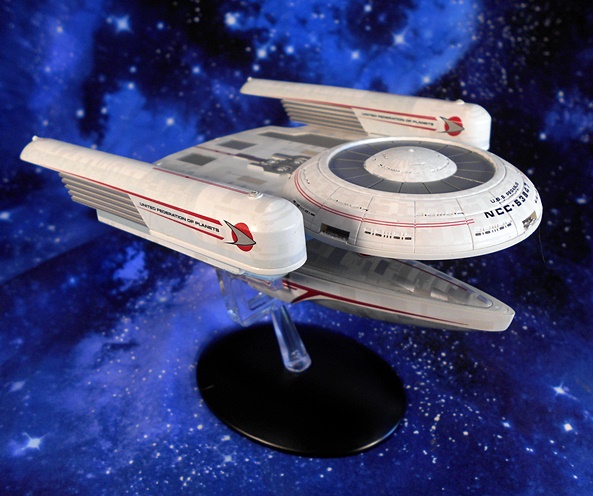




















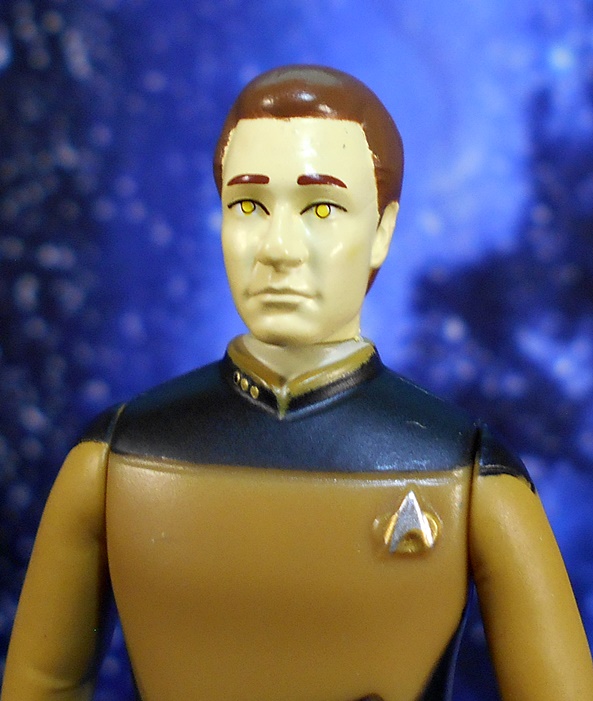


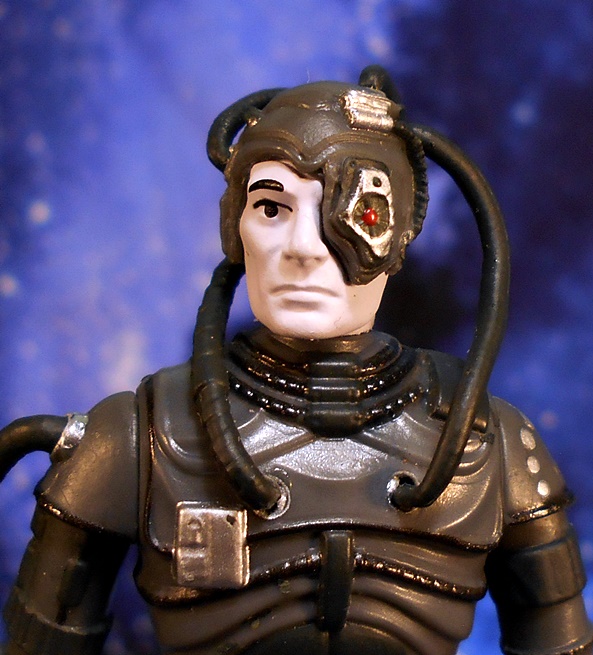

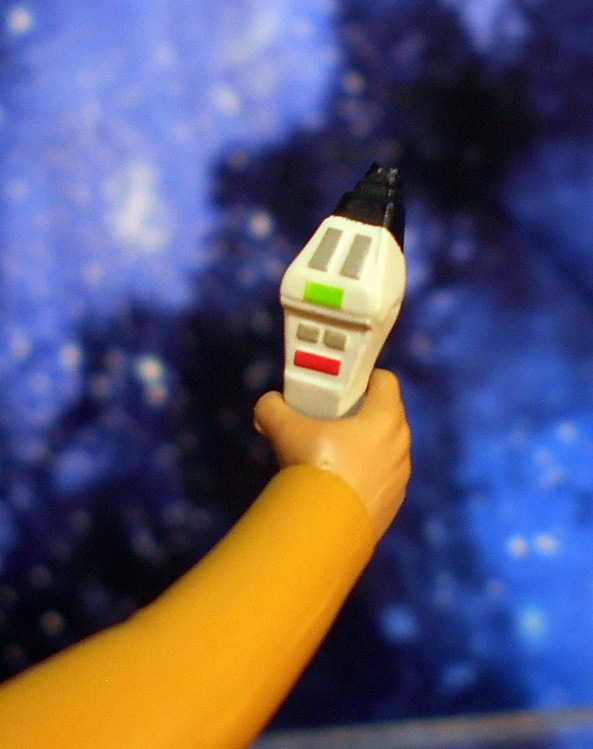
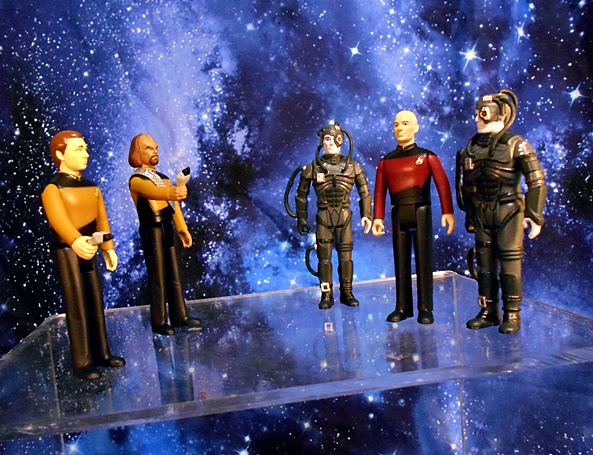
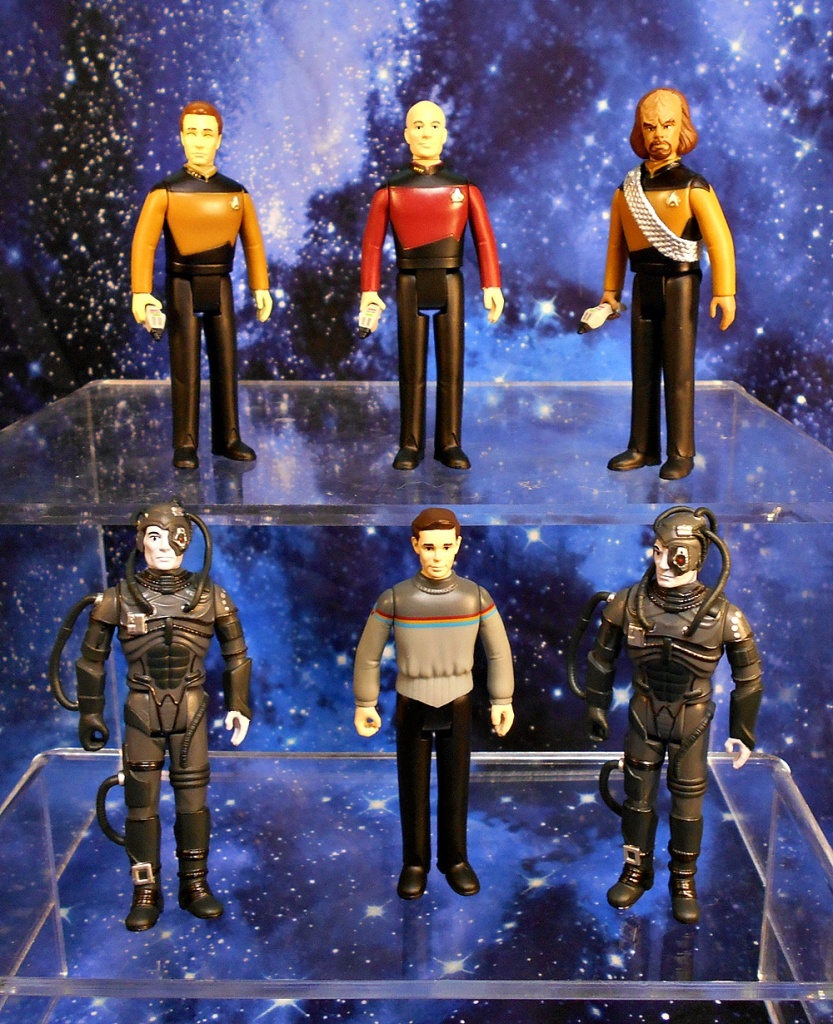


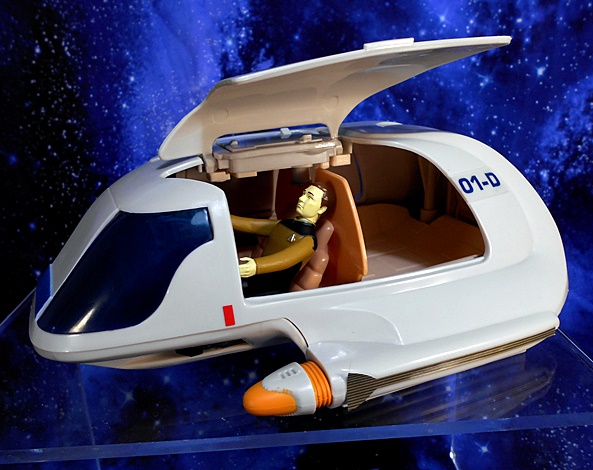






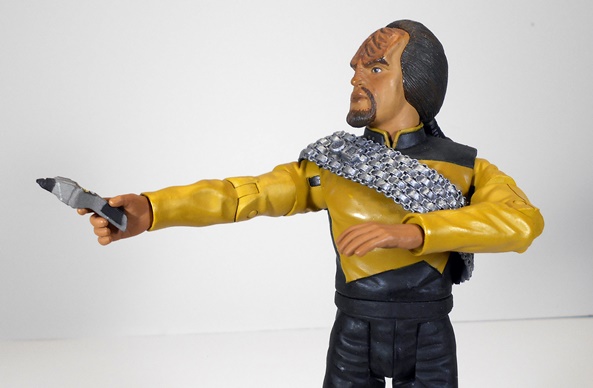









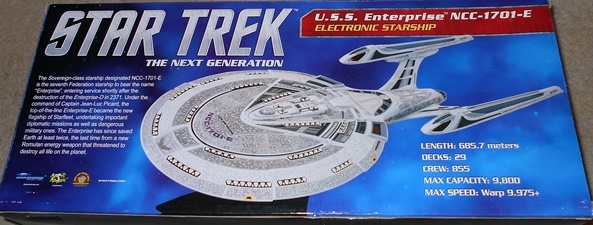








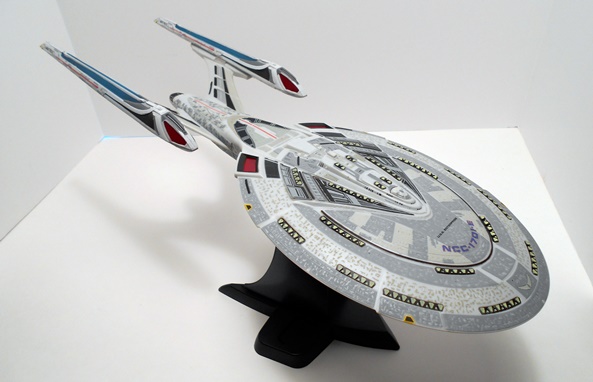
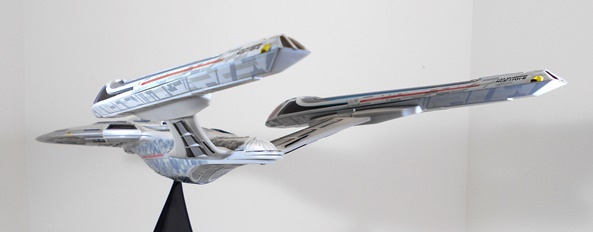

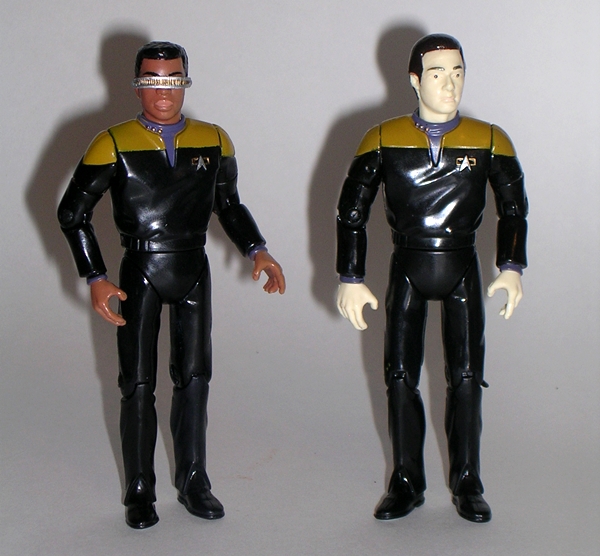

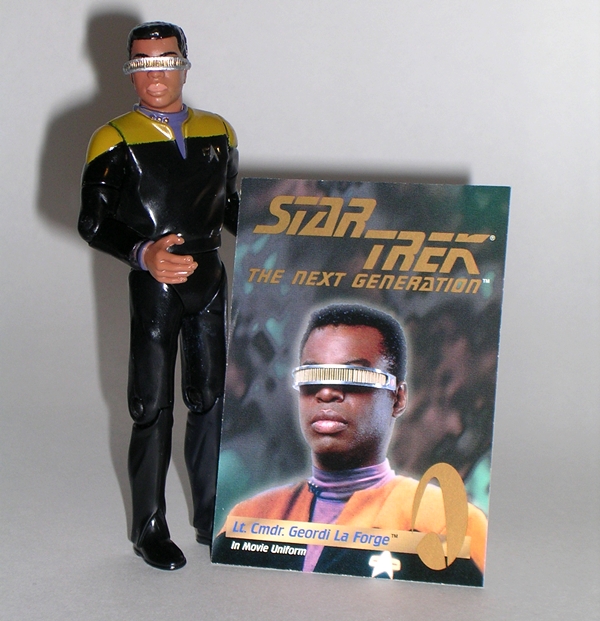
















 The huge window box is actually not quite as big as the Bird of Prey’s package, but it is deeper. It’s the same style of blue cloudy star field deco only this time you get a shot of Captain Jean-Luc Picard, with arms crossed, staring out approvingly at you, as if to say, “Well done on buying this ship.” That makes me happy. After all, deep down don’t we all really just want approval from Captain Picard? The Star Trek logo is in “The Original Series” font with “The Next Generation” below it. Wait… they can’t do that… can they? I’ll confess the mixing of the two generations looks weird, like it’s a knock off package or something. The front panel of the box is cut out to show the bulk of the ship, while still hiding the two
The huge window box is actually not quite as big as the Bird of Prey’s package, but it is deeper. It’s the same style of blue cloudy star field deco only this time you get a shot of Captain Jean-Luc Picard, with arms crossed, staring out approvingly at you, as if to say, “Well done on buying this ship.” That makes me happy. After all, deep down don’t we all really just want approval from Captain Picard? The Star Trek logo is in “The Original Series” font with “The Next Generation” below it. Wait… they can’t do that… can they? I’ll confess the mixing of the two generations looks weird, like it’s a knock off package or something. The front panel of the box is cut out to show the bulk of the ship, while still hiding the two 

 I was expecting a lot of detail, but I’ll confess the finished sculpt still exceeds my expectations. The Enterprise-D has a lot of surface space, and every bit of it is covered with panel lines. I mean, damn, you can practically see every single plate of tritanium-duranium alloy that went into the hull’s construction. The Escape Pod hatches are sculpted, the ridges on the Shuttle Bay doors, even the little docking hatches on the sides of the Torpedo Bay launchers. If Art Asylum left any details out, I sure as hell can’t find them. There is a little more assembly seaming on this ship than was evident on the Bird of Prey. It’s mostly noticeable along the aft edges of the ship and where the back of the neck meets the front two pieces. They aren’t terrible, but worth mentioning.
I was expecting a lot of detail, but I’ll confess the finished sculpt still exceeds my expectations. The Enterprise-D has a lot of surface space, and every bit of it is covered with panel lines. I mean, damn, you can practically see every single plate of tritanium-duranium alloy that went into the hull’s construction. The Escape Pod hatches are sculpted, the ridges on the Shuttle Bay doors, even the little docking hatches on the sides of the Torpedo Bay launchers. If Art Asylum left any details out, I sure as hell can’t find them. There is a little more assembly seaming on this ship than was evident on the Bird of Prey. It’s mostly noticeable along the aft edges of the ship and where the back of the neck meets the front two pieces. They aren’t terrible, but worth mentioning.




 The paintwork compliments the sculpted detail wonderfully. Every window is painted onto the ship’s skin from the random windows of crew quarters to the line of panels that runs across the wall of the Conference Room and even the viewports of Ten Forward. The Escape Pod hatches are painted tan and you’ve got a darker grey on the Shuttle Bay doors and the Phaser Array strips. The lettering is all crisp and hugs the hull better than what I remember seeing in the test shots. Of all the tiny details, I think the one that impresses me the most are the tiny scoring lines that run along the perimeter of all the Phaser Arrays. Holy shit that’s cool!
The paintwork compliments the sculpted detail wonderfully. Every window is painted onto the ship’s skin from the random windows of crew quarters to the line of panels that runs across the wall of the Conference Room and even the viewports of Ten Forward. The Escape Pod hatches are painted tan and you’ve got a darker grey on the Shuttle Bay doors and the Phaser Array strips. The lettering is all crisp and hugs the hull better than what I remember seeing in the test shots. Of all the tiny details, I think the one that impresses me the most are the tiny scoring lines that run along the perimeter of all the Phaser Arrays. Holy shit that’s cool!
 The Enterprise comes with two display stands and they are the biggest pieces of shit I’ve ever seen. They’re basically the same style of thin, opaque plastic pieces as the one that came with the Bird of Prey, only these feature the ball joint under the connection points and are sculpted with the Starfleet “Comm Badge” style insignia. They look cheap, but that’s not the problem I have with them. While the Bird of Prey used a fixed connection that works perfectly, these stands use ball joints and they work well until you manipulate them a couple of times and then they fail miserably. The ball joint just can’t handle the weird weight displacement of the ship and it constantly wants to drop the ship forward onto the Saucer Section. They will work fine if you want to pose the ship in an upward climb, but forget about getting it displayed parallel to the surface its standing on. You see those two side shots of the ship? Well, the stands won’t do that anymore. Hey guys, what the hell is the point of a poseable ball joint if it can only hold the ship in one position??? I’ve tried gumming it up with blue tack, which didn’t work. I may try some nail polish next.
The Enterprise comes with two display stands and they are the biggest pieces of shit I’ve ever seen. They’re basically the same style of thin, opaque plastic pieces as the one that came with the Bird of Prey, only these feature the ball joint under the connection points and are sculpted with the Starfleet “Comm Badge” style insignia. They look cheap, but that’s not the problem I have with them. While the Bird of Prey used a fixed connection that works perfectly, these stands use ball joints and they work well until you manipulate them a couple of times and then they fail miserably. The ball joint just can’t handle the weird weight displacement of the ship and it constantly wants to drop the ship forward onto the Saucer Section. They will work fine if you want to pose the ship in an upward climb, but forget about getting it displayed parallel to the surface its standing on. You see those two side shots of the ship? Well, the stands won’t do that anymore. Hey guys, what the hell is the point of a poseable ball joint if it can only hold the ship in one position??? I’ve tried gumming it up with blue tack, which didn’t work. I may try some nail polish next.
 So two stands? Yes, The complete Enterprise displays on either stand by plugging it into the hole closest to the Deflector Dish. You can also display the Enterprise separated by plugging the smaller stand into the middle hole of the Star Drive section and using the larger stand for the Saucer Section. While I doubt I’ll ever display the ship separated, it’s very cool to have this option. The instructions show a plug that can be put into the hole of the Saucer Section to cover it up when you are displaying the ship as one piece. It’s a great idea, but sadly no such plug was included in my box.
So two stands? Yes, The complete Enterprise displays on either stand by plugging it into the hole closest to the Deflector Dish. You can also display the Enterprise separated by plugging the smaller stand into the middle hole of the Star Drive section and using the larger stand for the Saucer Section. While I doubt I’ll ever display the ship separated, it’s very cool to have this option. The instructions show a plug that can be put into the hole of the Saucer Section to cover it up when you are displaying the ship as one piece. It’s a great idea, but sadly no such plug was included in my box.






